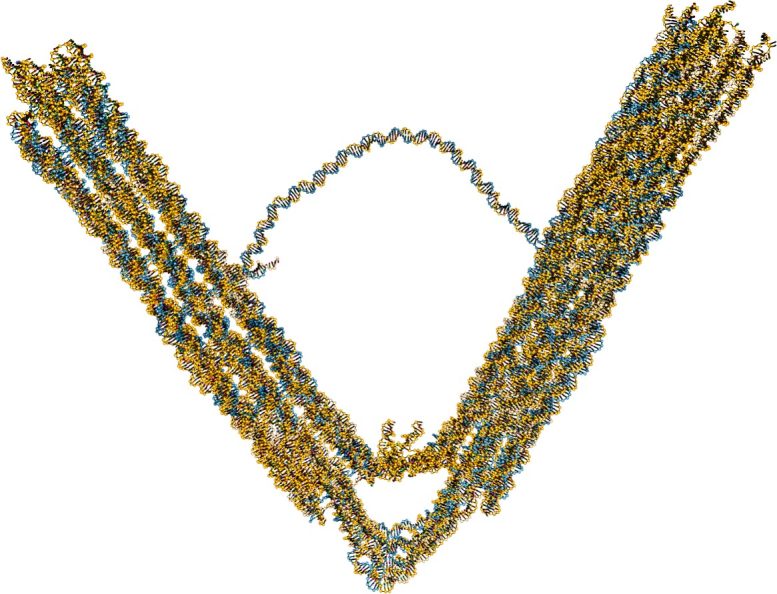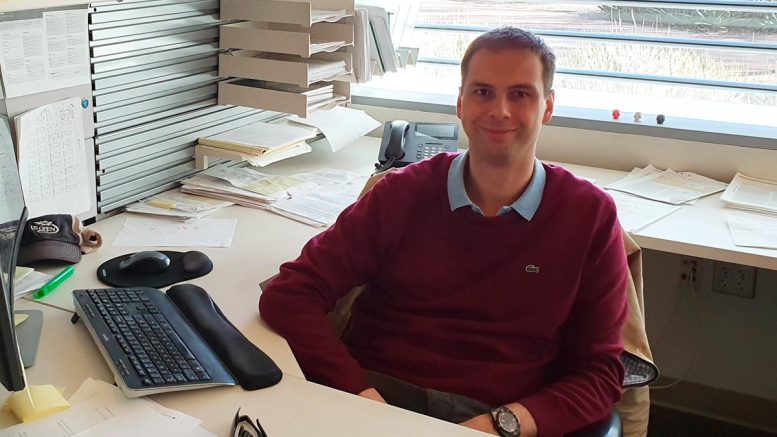
An international team of scientists has recently developed a novel type of nano engine made of DNA. It is driven by a clever mechanism and can perform pulsing movements. The researchers are now planning to fit it with a coupling and install it as a drive in complex nanomachines. Their results were published on October 19 in the journal Nature Nanotechnology.
Collaborative Efforts and Tools Used
Petr Šulc, an assistant professor at Arizona State University’s School of Molecular Sciences and the Biodesign Center for Molecular Design and Biomimetics, has collaborated with professor Famulok (project lead) from the University of Bonn, Germany and professor Walter from the University of Michigan on this project.
Šulc has used his group’s computer modeling tools to gain insights into design and operation of this leaf-spring nano engine. The structure is comprised of almost 14,000 nucleotides, which form the basic structural units of DNA.
“Being able to simulate motion in such a large nanostructure would be impossible without oxDNA, the computer model that our group uses for design and design of DNA nanostructures,” explains Šulc. “ It is the first time that a chemically powered DNA nanotechnology motor has been successfully engineered. We are very excited that our research methods could help with studying it, and are looking forward to building even more complex nanodevices in the future.”
Functional Comparison and Mechanism
This novel type of engine is similar to a hand grip strength trainer that strengthens your grip when used regularly. However, the motor is around one million times smaller. Two handles are connected by a spring in a V-shaped structure.

In a hand grip strength trainer, you squeeze the handles together against the resistance of the spring. Once you release your grip, the spring pushes the handles back to their original position. “Our motor uses a very similar principle,” says professor Michael Famulok from the Life and Medical Sciences (LIMES) Institute at the University of Bonn. “But the handles are not pressed together but rather pulled together.”
The researchers have repurposed a mechanism without which there would be no plants or animals on Earth. Every cell is equipped with a sort of library. It contains the blueprints for all types of proteins that each cell needs to perform its function. If the cell wants to produce a certain type of protein, it orders a copy from the respective blueprint. This transcript is produced by the enzymes called RNA polymerases.
RNA Polymerases Drive the Pulsing Movements
The original blueprint consists of long strands of DNA. The RNA polymerases move along these strands and copy the stored information letter by letter. “We took an RNA polymerase and attached it to one of the handles in our nanomachine,” explains Famulok, who is also a member of the transdisciplinary research areas “Life & Health” and “Matter” at the University of Bonn. “In close proximity, we also strained a DNA strand between the two handles. The polymerase grabs on to this strand to copy it. It pulls itself along the strand and the non-transcribed section becomes increasingly smaller. This pulls the second handle bit by bit towards the first one, compressing the spring at the same time.”

The DNA strand between the handles contains a particular sequence of letters shortly before its end. This so-called termination sequence signals to the polymerase that it should let go of the DNA. The spring can now relax again and moves the handles apart. This brings the start sequence of the strand close to the polymerase and the molecular copier can start a new transcription process: The cycle then repeats. “In this way, our nanomotor performs a pulsing action,” explains Mathias Centola from the research group headed by professor Famulok, who carried out a large proportion of the experiments.
Energy Source and Future Prospects
This motor also needs energy just like any other type of motor. It is provided by the “alphabet soup” from which the polymerase produces the transcripts. Every one of these letters (in technical terminology: nucleotides) has a small tail consisting of three phosphate groups – a triphosphate. In order to attach a new letter to an existing sentence, the polymerase has to remove two of these phosphate groups. This releases energy which it can use for linking the letters together. “Our motor thus uses nucleotide triphosphates as fuel,” says Famulok. “It can only continue to run when a sufficient number of them are available.”

The researchers were able to demonstrate that the motor can be easily combined with other structures. This should make it possible for it to, for example, wander across a surface – similar to an inchworm that pulls itself along a branch in its own characteristic style. “We are also planning to produce a type of clutch that will allow us to only utilize the power of the motor at certain times and otherwise leave it to idle,” explains Famulok. In the long term, the motor could become the heart of a complex nanomachine. “However, there is still a lot of work to be done before we reach this stage.”
Šulc’s Lab and Its Achievements:
Šulc’s lab is highly interdisciplinary and applies broadly the methods of statistical physics and computational modeling to problems in chemistry, biology and nanotechnology. The group develops new multiscale models to study interactions between biomolecules, particularly in the context of design and simulations of DNA and RNA nanostructures and devices.
“Just as complex machines in our everyday use — planes, cars, and chips in electronics — require sophisticated computer-aided design tools to make sure they perform a desired function, there is a pressing need to have access to such methods in the molecular sciences.”
Professor Tijana Rajh, director of the School of Molecular Sciences, said, “Petr Šulc and his group are doing extremely innovative molecular science, using the methods of computational chemistry and physics to study DNA and RNA molecules in the context of biology as well as nanotechnology. Our younger faculty members in the School of Molecular Sciences have an extraordinary record of achievement, and Professor Šulc is an exemplar in this regard.
Bio-Nanotechnology
DNA and RNA are the basic molecules of life. They fulfill many functions, including information storage and information transfer in living cells. They also have promising applications in the field of nanotechnology where designed DNA and RNA strands are used to assemble nanoscale structures and devices. As Šulc explains, “It is a little bit like playing with Lego blocks except that each Lego block is only a few nanometers (a millionth of a millimeter) in size, and instead of putting each block into the place where it should go, you put them inside a box and shake it randomly until only the desired structure comes out.”
“The promising applications of this field include diagnostics, therapeutics, molecular robotics, and building of new materials,” says Šulc. “My lab has developed the software to design these blocks, and we work closely with experimental groups at ASU as well as other universities in the U.S. and Europe. It is exciting seeing our methods used to design and characterize nanostructures of increasing complexity, as the field progresses and we achieve new advanced designs and successfully operate them at nanoscale.”
Reference: “A rhythmically pulsing leaf-spring DNA-origami nanoengine that drives a passive follower” by Mathias Centola, Erik Poppleton, Sujay Ray, Martin Centola, Robb Welty, Julián Valero, Nils G. Walter, Petr Šulc and Michael Famulok, 19 October 2023, Nature Nanotechnology.
DOI: 10.1038/s41565-023-01516-x
This research was supported by ERC grant no 101040035.
1 Comment
science rocks